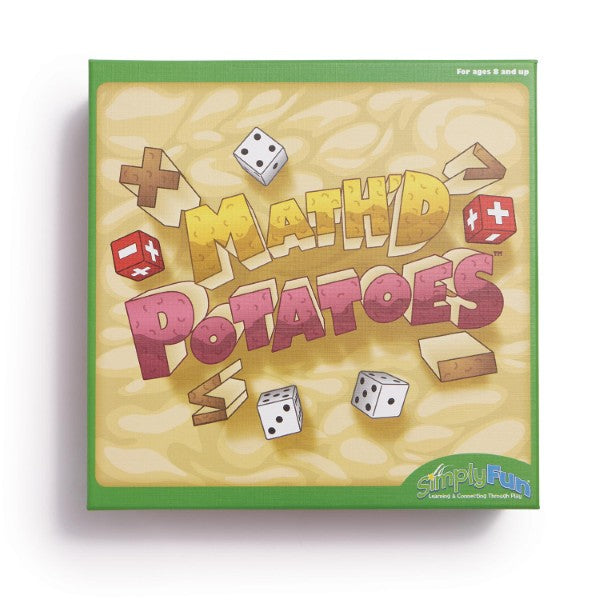
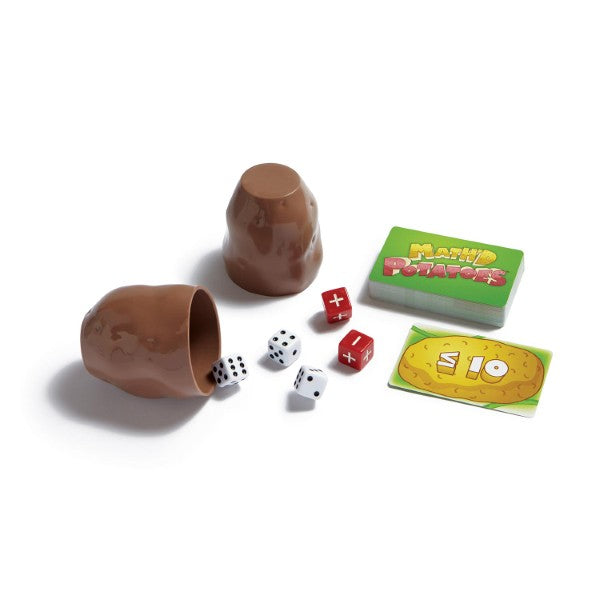
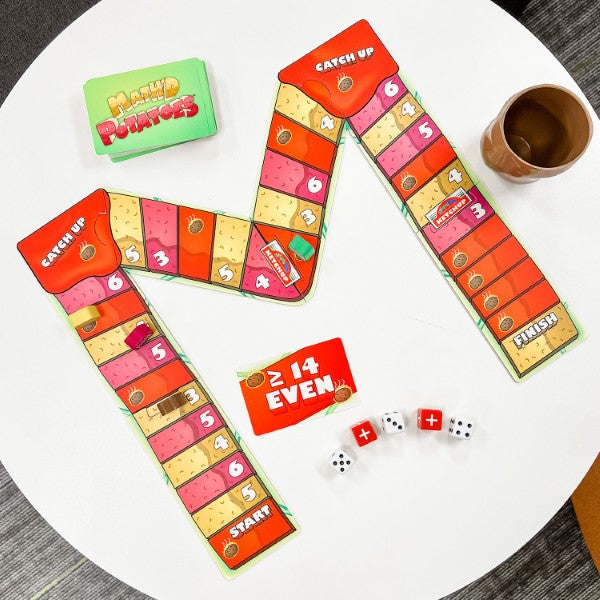
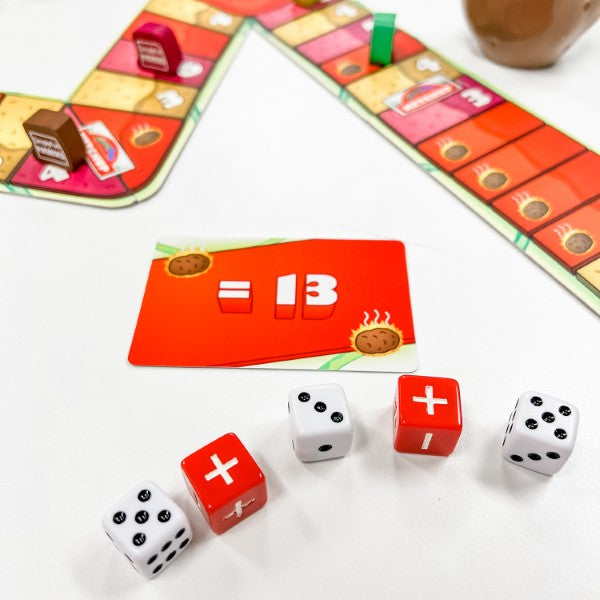
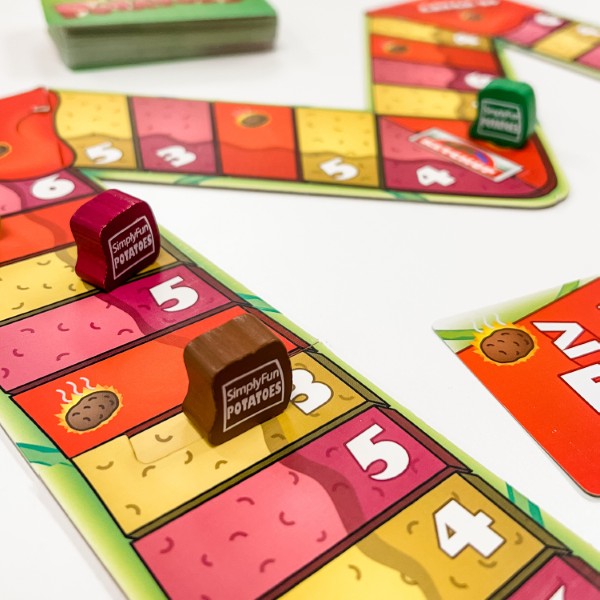


Collapsible content
This is a perfect math game for upper elementary kids working on problem solving skills, and practicing basic math involving plus and minus. It’s designed for 2-4 players, ages 8 and up, but works well for teams of players as well.
The game comes with sixty math challenge cards, four spud cups and a set of dice for each player. There are basic numbered dice, as well as special operator dice that show plus and minus signs. It also includes a game board shaped like an M and pawns that resemble tiny sacks of potatoes.
Math’d Potatoes is made up of several small math challenges, each one is an opportunity to work on problem solving, specifically math problems using plus and minus. Some challenges use the concepts of less than or greater than and every time there is a group challenge players want to quickly be the first to find a solution.
Here’s how to roll your dice. Always use a spud cup. Put the dice into the open end of the cup, cover it with your hand and shake!
You get to decide what order to put your dice to solve the current challenge.
1+5-6 =0
1+6-5 =2
5+6-1 =10
You get the idea…
If you need to reroll, you may pick up all your dice, or set aside some to preserve their values. On future rerolls, you can change your mind and put any dice back into the cup, even starting over.
Ok, let’s play Math’d Potatoes… In this game, there is no starting player. Since the game starts on a Hot Potato space, everyone participates in the first challenge!
Turn over the top card and all players race at once to see who can complete it first. Whoever wins this challenge, rolls one die and moves ahead that many spaces as their reward.
Future challenges might be group activities, or need to be completed alone. Here are some examples of what you might face:
> Total greater than a target number
< Total less than a target number
= Total exactly equal to a target number
ODD Total is an odd number
EVEN Total is an even number
MAX Everyone rolls once and highest wins
When the leading player passes one of the ketchup packets on the game board, all other players may advance to the “catch up” space behind this player. (Players who are already past this space do not move backward.) This game element prevents players from falling too far behind, and keeps the game moving.
The first player to reach the final space on the game board is a “sweet potato” and wins the game.
When teaching this game to new people, act as the “game show host” and keep the game moving. Turn over cards for the group, announce the next challenge aloud, make sure everyone’s clear if it’s a hot potato, or who is performing the challenge alone. Just generally keep things flowing, so the game doesn’t feel chaotic.
Math’d Potatoes is definitely my kind of math game - where the math is simple, everyone is involved in the action, and we all get a chance to shine.


Core Standard*: Math
Math
- Operations and Algebraic Thinking
- Represent and solve problems involving addition and subtraction. Grade Levels 1st, 2nd
- Add and subtract within 20. Grade Levels 1st, 2nd
- Number & Operations in Base 10
- Understand place value. Grade Level 1st
- Mathematical Practice
- Make sense of problems and persevere in solving them. Grade Levels 3rd, 4th
- Model with mathematics. Grade Levels 3rd, 4th
- Look for and make use of structure. Grade Levels 3rd, 4th
- Look for and express regularity in repeated reasoning. Grade Levels 3rd, 4th


Explore
What Does Child Do To Use Skill In The Game?
Children need to examine their dice to determine if they have the needed amount indicated on the drawn Challenge Card.
How Parents Can Assist Learning
Math'd Potatoes requires children to think about both addition and subtraction options. Parents can encourage children to move the dice around to visualize multiple options prior to determining final choice. Also, children need to consider which dice to keep and which to re-roll. Help children by asking them to "Wait. Look. Think." This will help with impulsivity and planning. Also, using such cues can give children a model for future play.
Learning Implications and Educator Support
Math'd Potatoes requires children to think about both addition and subtraction options. Educators can encourage children to move the dice around to visualize multiple options prior to determining final choice. Additionally, ask children to say aloud the challenge so that they can focus on the goal of their turn. Also, children need to consider which dice to keep and which to re-roll. Help children by asking them to "Wait. Look. Think." This will help with impulsivity and planning. Also, using such cues can give children a model for future play.
Determine
What Does Child Do To Use Skill In The Game?
Children need to examine their dice to determine if they have the needed amount indicated on the drawn Challenge Card.
How Parents Can Assist Learning
Math'd Potatoes requires children to think about both addition and subtraction options. Parents can encourage children to move the dice around to visualize multiple options prior to determining final choice. Also, children need to consider which dice to keep and which to re-roll. Help children by asking them to "Wait. Look. Think." This will help with impulsivity and planning. Also, using such cues can give children a model for future play.
Learning Implications and Educator Support
Math'd Potatoes requires children to think about both addition and subtraction options. Educators can encourage children to move the dice around to visualize multiple options prior to determining final choice. Additionally, ask children to say aloud the challenge so that they can focus on the goal of their turn. Also, children need to consider which dice to keep and which to re-roll. Help children by asking them to "Wait. Look. Think." This will help with impulsivity and planning. Also, using such cues can give children a model for future play.
Compare
What Does Child Do To Use Skill In The Game?
Children compare the various addition and subtraction totals in their dice after they are thrown.
How Parents Can Assist Learning
Math'd Potatoes requires children to think about both addition and subtraction options. Parents can encourage children to move the dice around to see and compare multiple options prior to determining final choice.
Learning Implications and Educator Support
Math'd Potatoes requires children to think about both addition and subtraction options. Edcuators can encourage children to move the dice around to see and compare multiple options prior to determining final choice. Also, children need to consider which dice to keep and which to re-roll. Ask children to tell you why they are thinking about re-rolling certain dice. This can reveal their strategic thinking and mathematical understanding.
Remember
What Does Child Do To Use Skill In The Game?
Children need to remember the meaning of the various math symbols so they understand what their target number is on their dice.
How Parents Can Assist Learning
Parents should explain all symbols prior to playing the game. Give clues to help aid memory. For example, for the symbol ">", the parent can say "This left side of the symbol is wide and big, so you are looking for a bigger number."
Learning Implications and Educator Support
Educators should explain all symbols prior to playing the game. Give clues to help aid memory. For example, for the symbol ">", the educator can say "This left side of the symbol is wide and big, so you are looking for a bigger number." If children are having difficulty with certain concepts, such as "greater than or equal to", remove those cards and introduce them later.
Experiment
What Does Child Do To Use Skill In The Game?
Children have several throws to try to obtain the desired target amount. With each through children look at numerous options.
How Parents Can Assist Learning
Math'd Potatoes requires children to think about both addition and subtraction options. Parents can encourage children to experiment by movig the dice around to see different equation results. Also, children need to consider which dice to keep and which to re-roll. To aid in improve decision-making, allow children to try 2 or 3 different re-roll combinations and select the best option.
Learning Implications and Educator Support
Math'd Potatoes requires children to think about both addition and subtraction options. Educators can encourage children to experiment by movig the dice around to see different equation results. Also, children need to consider which dice to keep and which to re-roll. To help refine strategic decision making ability, allow children to try 2 or 3 different re-roll combinations and select the best option. Let children use small blocks to manipulate various combinations. This will assist children who need more concrete support to learn.
Practice
What Does Child Do To Use Skill In The Game?
Each throw of the dice gives children practice with adding and subtracting and solving equations with numbers up to six.
How Parents Can Assist Learning
Using positive reinforcement, like "Great combination!", parents can encourage children to practice in order to master elements of the game.
Learning Implications and Educator Support
Using positive reinforcement, like "Great combination!", educators can encourage children to practice in order to master elements of the game. Let children use small blocks to manipulate various combinations. This will assist children who need more concrete support to learn.
Solve
What Does Child Do To Use Skill In The Game?
This is the primary purpose of the game is for children to solve simple equations with numbers up to six.
How Parents Can Assist Learning
Parents may guide children to see that they actually have the right dice to make the equation. Break down the dice into sets, so the child can see the problem in segments. For example, if the Challenge card says =8, and the child throws 2, -, 6, 4, +, the parents might suggest the child add their 6 + 4 dice. When the child says, "That's 10." The parents then asks, "What's left?" The child responds "- 2. That's 8!"
Learning Implications and Educator Support
Educators may guide children to see that they actually have the right dice to make the equation. Break down the dice into sets, so the child can see the problem in segments. For example, if the Challenge card says =8, and the child throws 2, -, 6, 4, +, the educator might suggest the child add their 6 + 4 dice. When the child says, "That's 10." The educator then asks, "What's left?" The child responds "- 2. That's 8!"
Review
What Does Child Do To Use Skill In The Game?
Players may review if encouraged. See Implications for Learning and Adult Support.
How Parents Can Assist Learning
Reviewing previous actions is important for learning. Parents can ask children to think about what they did before. "What do you need to think about?" "Why did that work so well?" "Tell us how you did that?"
Learning Implications and Educator Support
Reviewing previous actions is important for learning. Educators can ask children to think about what they did before. "What do you need to think about?" "Why did that work so well?" "Tell us how you did that?"
Demonstrate
What Does Child Do To Use Skill In The Game?
Players may demonstrate if encouraged. See Implications for Learning and Adult Support.
How Parents Can Assist Learning
Although not required in the game, parents can help children practice and formulate a deeper understanding of mathematical principles by asking them to demonstrate or explain their thinking.
Learning Implications and Educator Support
Although not required in the game, educators can help children practice and formulate a deeper understanding of mathematical principles by asking them to demonstrate or explain their thinking.
*Data compiled from CCSSI ELA Standards, WA Science Standards, and Washington Social Studies Standards


Cognitive
Suggestions for How to Modify Play Experience
For cognitively challenged children, the game can be simplified by taking out the Challenge card and the subtraction operation dice. This will allow children to concentrate on only one operation, addition. They can move forward one step for every correct addition they make. Allow children to use their fingers or manipulatives if they need them.
After children understand the addition, concentrate on just subtraction. Remove the addition operation dice. With every throw, children can choose two dice to subtract. If correct they move forward one. If they can subtract two numbers they move forward two, etc. Allow children to use their fingers or manipulatives if they need them.
Work in pairs or teams. Ask children who understand addition and subtraction to help their partner or teammates. Give them manipulatives (such as pennies) to use to demonstrate their thinking.
Communication
Suggestions for How to Modify Play Experience
Once the children understand the math symbols, the child with language needs can be the "Card Reader." This will give the child more confidence in speaking with a group.
Ask the child who needs practice with communication to explain the directions to the other players. The adult can explain the directions to the child beforehand.
Chant as you shake the dice cup, "One, potato, two potato, three potato four! Dump the dice and there's one more!"
Sensorimotor
Suggestions for How to Modify Play Experience
Once the children understand the math symbols, the child with language needs can be the "Card Reader." This will give the child more confidence in speaking with a group.
Ask the child who needs practice with communication to explain the directions to the other players. The adult can explain the directions to the child beforehand.
Chant as you shake the dice cup, "One, potato, two potato, three potato four! Dump the dice and there's one more!"
Social Emotional/Behavioral
Suggestions for How to Modify Play Experience
Work in pairs to discuss the problem and come up with solution.
Ask the shy child to explain how to play the game to other children. They can demonstrate as the adult talks if they don't like to talk in front of others. This will build their confidence.
Vision
Suggestions for How to Modify Play Experience
Prior to playing the game, have all the children help you make fives sets of large construction paper squares representing each side of a die. Make them large enough for the child to see. For example, five sheets with a large circle in the middle, five sheets with two circles in a diagonal, etc. These represent the five thrown dice. Make the large circles with high contrast, for instance, bright red circles on white paper. You can also you form circle-shaped stickers that the vision impaired child can feel. Have the vision impaired child play with a sighted peer. Someone reads out what is on the Challenge card. The sighted partner reads out the numbers on the dice thrown and the child with vision concerns arranges the large papers as if they were dice to solve the problem.
Hearing
Suggestions for How to Modify Play Experience
This game uses visual cues, so the child can play with a demonstration of each step of the game.
*Data compiled from CCSSI ELA Standards, WA Science Standards, and Washington Social Studies Standards


Autism Strengths & Interests
Short Summary of Strengths & Interests
- Enjoys math, especially making up math problems.
- Is good at visualizing options, particularly with numbers.
- Prefers nonverbal activities that involve logic and reasoning.
Is good at matching visual items
This game is not appropriate
Has a good memory for sensory details, including visual, touch, taste and smell
This game is not appropriate
Has a good memory for words, phrases and dialouge
This game is not appropriate
Has a good memory for pictures, numbers and patterns
Is This Game Appropriate? Yes
Description
Children with autism are often skilled at manipulation of numbers. The game provides opportunities for these children to learn math symbols, practice addition and subtraction, and manipulate equations. Children can also learn and use number sequences to play the game faster. If working quickly is frustrating for a child the game could be modified, so that every player who obtains the right answer rolls a die and moves forward on the board that many spaces. Players can also work together in teams, which can build communication and problem solving skills.
Likes to put things in order or a sequence
Is This Game Appropriate? Yes
Description
Math'd Potatoes is great for children who have an interest in math and can do addition and subtraction. It requires players to order the dice and create a formula that meets the requirements of a challenge card. Children with autism often like patterns because they are predictable. Children can learn flexibility by rearranging the dice until they are able to find a winning formula, or determine that no winning formula can be made on that turn. If working quickly is frustrating for a child the game could be modified, so that every player who obtains the right answer rolls a die and moves forward on the board that many spaces. Players can also work together in teams, which can build communication and problem solving skills.
Learns through visualizing or "replaying" actions in their mind
This game is not appropriate
Likes activities with rules, such as math and phonics
Is This Game Appropriate? Yes
Description
The rules for addition and subtraction operations are needed to make an accurate equation in Math'd Potatoes. Children who understand the rules and can accurately create the equation will do well with this game.
Is very concrete and literal
This game is not appropriate
Learns in small "chunks" (for example, phone numbers are 3 chunks of number xxx-xxx-xxxx that are combined together)
Is This Game Appropriate? Yes
Description
Some children are strong in learning by "chunks", e.g. they assemble information into a single concept and then combine that with other concepts to create and/or remember something more complex. In Math'd Potatoes, they learn a simple equation (ex: 3+4 = 7) as one chunk. Then they add or subtract another number to complete the equation (ex: 3 + 4 = 7. Then, 7 - 1 = 6)
Is good at nonverbal reasoning and logic
Is This Game Appropriate? Yes
Description
Nonverbal reasoning is needed to determine how to create a winning formula. Players can arrange and rearrange the dice in any order until one player makes a winning equation. However, no one is required to tell others about their reasoning, which is good for children who are good at logic and reasoning but prefer not to speak during play or discuss their thinking process.
Likes spatial problem solving
This game is not appropriate
Can read well with good vocabulary, though may not fully comprehend content
This game is not appropriate
Likes to use and has good fine motor skill
This game is not appropriate
Likes established routines or set ways of doing things
This game is not appropriate
Likes manipulating, constructing or building things
This game is not appropriate
Likes to use and has good musical abilities
This game is not appropriate
Likes to use and has good drawing skills
This game is not appropriate
Autism Special Considerations
Appears to ignore other's communication and/or has difficulty giving eye contact to a communication partner
Is This Game Appropriate for Child with Characteristic? Yes
Can Child with Characteristic Play Game w/o Modification? Yes
Strategies for Developing Compensatory Skills:
Sit or stand at an angle to the child, so direct eye contact is not needed.
Look at the game instead of each other.
Use unusual or exaggerated inflection to begin a communication about the game. This attracts the child's attention.
Has difficulty understanding complex verbal directions
Is This Game Appropriate for Child with Characteristic? Yes
Can Child with Characteristic Play Game w/o Modification? No
Strategies for Developing Compensatory Skills:
Break down directions into small steps. Don't go through all the directions at once.
Combine short verbal instructions with visual and physical examples of each step.
Use photos to illustrate what needs to be done. These can be taken ahead of time. The combination of pictures and actions reinforces learning the steps. Also, take pictures during the game for use in later discussions about the game and what happened.
Use hand-over hand guidance if needed, so children feel the actions as the directions are being given. This helps develop the child's memory for the correct movements. Gradually reduce the support as the game is learned.
Check for comprehension by asking the child to show you what to do next. Let children read the directions as they are explained. Visualizing the words is often a stronger learning method for children with autism.
Uses vocabulary inaccurately or demonstrates echolalia (repeating another's speech)
Is This Game Appropriate for Child with Characteristic? Yes
Can Child with Characteristic Play Game w/o Modification? No
Strategies for Developing Compensatory Skills:
Respond to immediate echolalia (repeating what was just said) by rephrasing the child's response into a correct format, so the child can hear and repeat that phrase. For example, assume you are playing with a child named Andy and you say, "Your turn," and Andy repeats, "Your turn." You can say, "It's Andy's turn. You say, my turn." This allows the child to hear and repeat the correct response. Eventually, the child will pick up the pattern of response.
Delayed echolalia (repetition of previously heard comments) may have a hidden meaning or association. Look for connection in the phrase used to the current situation. For example, the child says, "After these messages we'll be right back!" Think what the repeated phrase is associated with for the child. Try to interpret what is meant and rephrase it for the child. For example, you might respond by saying, "It sounds like you want a break for a few minutes. Is that what you mean? You can tell me, 'I need a break.'"
Gets stuck repeating a verbal topic or physical actions and/or has difficulty attending to others' actions or topic.
Is This Game Appropriate for Child with Characteristic? Yes
Can Child with Characteristic Play Game w/o Modification? No
Strategies for Developing Compensatory Skills:
Incorporate a preferred topic into the game to increase motivation. For example, if the child is fixated on a particular character, like a favorite super hero, ask what the character would do if they were playing?
Practice phrases for commenting on others' play actions. For example, you say to Joe (who is playing with you), "Right on! Your answer matches the equation." Then ask the child, "What did Joe do? "
Remind children about listening and watching others' before making their own comment or action.
Use a motivation toy or object to gain the child's attention. For example, a preferred wind-up toy can be placed on the board when it is the child's turn. The child gets to wind up the toy after completing their turn.
Use the child's finger to point to what needs attention. They will attend to their finger first, and then the adult can point out the object they are pointing at.
Extend the child's action to make a correct response. For example, if the child arranges the dice in only one way, say, "That is one way to order the dice. Try another way."
Reinforce attention and actions by commenting on what was done correctly. For example, "You got it in two throws!"
Has difficulty producing speech/communication
Is This Game Appropriate for Child with Characteristic? Yes
Can Child with Characteristic Play Game w/o Modification? Yes
Strategies for Developing Compensatory Skills:
Use augmentative communication, such as picture cards. For example, a picture of person pointing to another person means "your turn."
Use gestures and sign language to illustrate actions or concepts. For example, use the sign for 'finished' (two hands facing down, spread out from the middle of the body), point to the next player and say, "I'm done. It's your turn." The signs and gestures add a visual component to support understanding.
Extend the child's sounds into words or words into phrases to provide a model. For example, if the child says, "more," the adult can say, "Yes. You can ROLL AGAIN."
Provide at least 10 seconds wait time for the child to process or produce responses. It may take longer to formulate a thought or response for children with special needs.
Has difficulty sequencing multi-step actions and/or doing complex abstract tasks
Is This Game Appropriate for Child with Characteristic? Yes
Can Child with Characteristic Play Game w/o Modification? No
Strategies for Developing Compensatory Skills:
Use physical actions to walk through steps numerous times, with less support for the final step each time. This is called "shaping." For example, walk through the steps of throwing the dice, moving the dice into different arrangements, and finding a solution. Then do the first two steps and say, "What do you do next?"
Make picture cards of each step of a game, so the child can refer to the pictures for the next step in the sequence.
Supplement board illustrations and pieces with additional tangible materials. For example, use counting cubes or plastic letters so the child can physically manipulate materials.
Use pictures to illustrate concepts of an equation. For example have sample pictures of blocks lined up in a row to match the equation on the dice. This illustrates the concept .
Demonstrates difficulty initiating and maintaining social interactions
Is This Game Appropriate for Child with Characteristic? Yes
Can Child with Characteristic Play Game w/o Modification? Yes
Strategies for Developing Compensatory Skills:
Develop a social story to be read at the start of a game. A social story is a short booklet that illustrates how a child can use positive social skills. It includes two to five descriptive statements and a directive statement. For example: "When I watch others, I will know when it is my turn. Others like me when I take turns. I will watch what others do with their pieces and listen to what they say. Others like it when I talk about the game." Add photos or drawings of the child doing the actions described in the story.
Use video feedback of positive social behaviors. Video of actual play enables children to see what they or others did. Appropriate actions and interactions can then be discussed.
Acts out or demonstrates avoidance behaviors when frustrated, overwhelmed, or needs more sensory input.
Is This Game Appropriate for Child with Characteristic? Yes
Can Child with Characteristic Play Game w/o Modification? No
Strategies for Developing Compensatory Skills:
Reduce extraneous noise or allow the child to wear head phones or ear plugs if loud sounds cause anxiety.
A weighted vest worn during the game may provide additional pressure input and thus reduce fidgeting due to sensory needs. Pressure can be calming when used for no more than 20 minutes at a time.
Practice a phrase to ask for help and role play situations in the game where it is needed.
Provide techniques for self-calming, such as holding a special toy.
Allow time for movement. For example, a child who needs to move frequently can be given an opportunity to 'celebrate' their turn by running around the table or jumping up and down 10 times.
Has short attention span for non-preferred activities
Is This Game Appropriate for Child with Characteristic? Yes
Can Child with Characteristic Play Game w/o Modification? No
Strategies for Developing Compensatory Skills:
Provide a break when needed.
Use "when...then" phrases. For example, "When you take your turn, then I'll let you play with your toy."
Frequently remind the child of the goal of the game.
Incorporate a motivating activity as part of the play. For example, each player gets to manipulate a fun 'fidget' toy, such as a stress ball or squeeze toy.
Needs sameness or consistent routines and/or has difficulty with transitions from one activity to another
Is This Game Appropriate for Child with Characteristic? Yes
Can Child with Characteristic Play Game w/o Modification? No
Strategies for Developing Compensatory Skills:
Play games at the same time every day, so the child anticipates the game routine.
Change the location of the game, so the child may play in different rooms, at the table, or on the floor. This will build tolerance for variation. Prepare the child ahead time for the introduction of a new game. Talk about aspects that will be motivating for the child, and let them explore the parts of the game before setting out the whole game.
Provide a structure for placement of game pieces that can be the same each time the game is played. For example, have a specific location for where the board goes, the pieces, etc.Provide choices for how the child can be involved in set up or clean up. For example, you might ask, "Do you want to pass out the dice and cups or set up the board?"
Involve the child verbally and with actions for the transition to the game table or at the end of game play. For example, you might say, "Let's look at the pictures on the game box and guess what it is about."
Use an object cue. Let the child hold an object from the game or activity you want to introduce prior to the transition. For example, if you were intending to play Math'd Potatoes you would hand the child dice cup and say, "Look here is a dice cup. Let's find the dice that go inside."
Has difficulty understanding others' feelings, intentions, and the reasons for others' actions.
Is This Game Appropriate for Child with Characteristic? Yes
Can Child with Characteristic Play Game w/o Modification? No
Strategies for Developing Compensatory Skills:
Model and point out what others are feeling and comment on their facial expressions or words.
Discuss what causes feelings in others. For example, "You are happy because you got a right answer . But, look at Joe's face. He is not happy because he has to roll again."
Ask child to explain their own feelings and intentions.
Ask child to explain why other players did specific actions in the game.
*Data compiled from CCSSI ELA Standards, WA Science Standards, and Washington Social Studies Standards


Extra Ways to Play the Game
This game can be played in a simple or more advanced format. In the simple format, give each child 20-30 cards from the deck. Each child rolls the dice (3 number and 2 operator dice) and arranges the rolled dice in whatever way they think will move them forward. The children can use the cards in their hand face-down as markers. For instance if the child throws and arranges the dice as 3 + 2 -1, the child can place 3 cards length-wise, plus 2 more cards, then take away 1 card. This shows the child a concrete representation of adding and subtracting. Children each get three rolls, then see who is farthest down the path. The adult can help children learn how to use the numbers in different ways to get a higher number to go further. The more advanced play has children figure out their total first, and then lay down the total number of cards. This requires mental operations and is higher level.
Materials Needed
No additional materials required.
Developmental Benefits
The modified game requires no board, but uses the floor to illustrate space and number. The manipulation of equal sized objects helps children "see" more and less as well as one-to-one correspondence of number with objects. Performing number operations is a cognitive task and is fundmental to math operations.
Extra Ways to Play the Game
This game has children predict how many of a certain number are face up under all the dice cups. Each child takes the numbered dice only. Two children can play with five or six dice; three children can play with 4 dice. They shake and dump the dice under the cup. Don't lift the cups. Each child peaks to see what numbers are face up on the dice under his/her cup. The first child guesses how many dice of a given number are under both cups. The next person must either guess a higher number of dice (for example if a child says, "one 2, the next child must say" two 2's"); or the child can say the same number or a lower number of dice of a higher number (for example, if the first child says, two 3's, the second child can say, "two 4's" or "three 3's"). Each child's call must increase the numberof dice or the number called. When a child calls out an improbable number another child calls, "I doubt it!" meaning they don't think the other person has the number called under both cups. Both lift the cups and count the number die with the stated number on it. If there are at least as many dice showing the number called, that child wins. If there are less dice showing the number than the number called, the other child wins that round. (For example, the last child says "six 3's" and the other child says, "I doubt it." Both cups are lifted and the number of 3's are counted. If at least six 3's are visible, the child calling this wins; if less are seen the child calling "I doubt it" wins.)
Materials Needed
No additional materials required.
Developmental Benefits
This game teaches children to think about probability. They have to think about how many total dice are under all of the cups and what the chances are that a certain number will be rolled at one time. They can see only the dice under their own cup, so must guess what might be under the other(s). Children not only practice logical thinking, they learn to not be impulsive about their guesses.
Extra Ways to Play the Game
Call out a number and let children play with the dice to figure out different ways to combine the dice to get that number. See who can find the most ways to get the result desired. For example, if the adult says, "6," the child could write down, 1+5, 2 + 4, 3+3, 4+2, 5+ 1. They could also use subtraction to get 6. Give children small blocks or other small objects to use to play with the number combinations.
Materials Needed
Paper and pencil, blocks, pennies, or other small objects to manipulate.
Developmental Benefits
Learning that there are many ways to manipulate numbers to get the same result is an important mathematical understanding. Let children use real objects, so they can see the meaning of number in concrete visuals that can be transformed in numerous ways. The ability to change perspective is a critical cognitive skill.
Extra Ways to Play the Game
Each child throws his/her dice and arranges them to make the largest (or smallest) total number he or she can. Let children decide before they throw whether they want to try to get the largest or smallest number. Give one point for whoever wins each throw.
Materials Needed
No additional materials required.
Developmental Benefits
This modification helps children practice adding and subtracting and finding the results. With practice they will learn the effect of having different numbers and operations in each sequence. This is an important cognitive skills.
*Data compiled from CCSSI ELA Standards, WA Science Standards, and Washington Social Studies Standards
- Choosing a selection results in a full page refresh.
- Opens in a new window.









